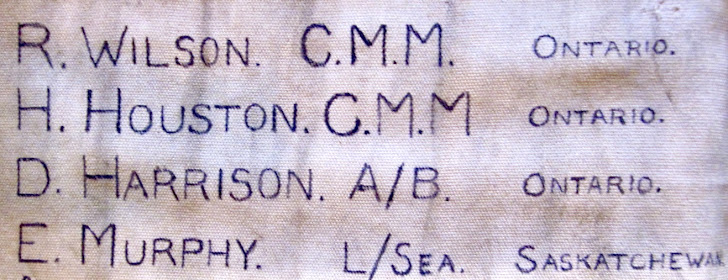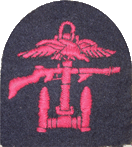Home to a Navy Hammock with My Father's Name on It
Filled with Treasure and a Link to 'The Crow's Nest' and More
I bussed to my appointment at Esquimalt's navy base from Victoria and approached
the cottage-museum's front door at 9:55 a.m., with five minutes to spare.
I was given white gloves and was allowed to unroll the navy hammock bearing names
of some members of the Canadian 80th Flotilla of Landing Crafts, Dad's included
Introduction:Those who look for information related to Canadian sailors in RCN or RCNVR or - as in my case - in RCNVR and Combined Operations, would do well to visit the Naval Military Museum in Esquimalt on the grounds of HMCS Naden. The red brick cottage-museum is easy to find, not a long walk from a gate on the eastern side of the property. Shelves are filled with valuable books and rare displays and helpful staff are on hand to assist.
I visited the museum in 2012 to see a navy hammock directly connected to my father and the 950 - 1,000 other members of RCNVR who also were allowed to volunteer for the Combined Ops organization during WWII. The hammock originally belonged to W. N. Katanna (LSM, Leading Stoker, Mechanic I think) and he gave it to Sub. Lt. Dave Rodgers during an ocean voyage around Africa aboard SS Silver Walnut on route to Sicily (and Operation HUSKY, the invasion of that island), summer of 1943.
The Canadian 80th Flotilla is boldly recalled by S/Lt. D. Rodgers
(whose name is atop Katanna's, a Russian stoker from Manitoba)
Sub. Lt. D. Rodgers returned the hammock decades later during a Navy reunion.
D. Harrison never saw it; he didn't return to the west coast after discharge, 1945.
After taking pictures of the hammock from every angle, even while standing upon chairs that surrounded the table upon which it lay, I toured the navy grounds. Fun was had by all!
Recently I found a link via Google to a photo of three sailors, all in RCNVR and likely all members of Combined Operations as well, one of whom had been featured in a series I put together entitled "Six Canadian Sailors Make Headlines." The photo was cleaner and higher resolution than the one I already had and linked to "Crow's Nest, News of Canada's Navy" (March 1944 issue) which is itself linked to CFB Esquimalt Naval Military Museum.
Photo Credit - The Crow's Nest, March 1944 issue, page 7
Once I was on the Naval Museum's home page I went to 'publications' and then to The Crowsnest. And once on The Crow's Nest page, I just scrolled down to see which PDF files/issues were available.
I noted there are several other publications as well - so much happy hunting lies ahead - and the archives are home to 17,000 digitized images ("Oh, I like good photos with clear captions!") and much more, e.g., as follows:
17,000+ digitized images in the museum database;
Key publications, including the The Navy List, and the first Crowsnest and Crow’s Nest magazines;
the Women’s Royal Canadian Naval Service wartime newsletter The Tiddley Times;
Files on Canadian Naval Vessels;
News cuttings and official Ship Histories;
Biographies of leading figures in the Canadian Navy;
Information about the history and development of what is now Canadian Forces Base Esquimalt;
Maps & Charts.... and more
Free Parking is available at HMCS Naden for certain Navy vessels : )
Front cover of a special edition, one year after D-Day France, June 1945
Many details related to the Canadian navy's role in the North Atlantic are shared by Canadian Naval Historian, Dr. Gilbert Norman Tucker:
The extensive article continues on Page 3 of June 1945 issue
Historian Dr. G. N. Tucker is the author of a two-volume set of significant navy history books entitled The Naval Service of Canada, printed in 1952. I was able to purchase the set at the Canadian War Museum in Ottawa and found a passage in Volume 2 about the development of the Combined Operations training camp on Vancouver Island in 1943. It was there that several RCNVR and Combined Ops veterans of two-year's overseas service (including my father; at Dieppe, North Africa, Sicily and Italy) continued their volunteer service by assisting with the training of new recruits.
My father and several mates arrived at Givenchy III in January 1944
Related photos from the collection of L.S. Cox'n Doug Harrison:
Simcoe; Buryl McIntyre, Norwich; Chuck Rose, Chippewa Ontario
"All dressed up with somewhere to go" - West Coast of Canada
"Just goofin' around." January, 1944, Union Station, Toronto
CN train's water stop in Hornepayne, ONT, January 1944
Don, Chuck, Buryl (back) Joe, Don Westbrook (Hamilton)
The "Slingshot Commandos" on The Goose Spit, Comox
Outside wooden cabins. Want plumbing? Grab a shovel.
Some navy nicknames appear. Doug "Cactus" Harrison, etc.
Last paragraph above ends... "the North Atlantic."
Article continues on page 7 of The Crow's Nest
The article below, found on page 12 of The Crow's Nest, refers directly to "four Canadian flotillas of landing craft" manned by "the young Canucks" that travelled to the West Coast of Canada by train six months after the invasion of Sicily.
The four flotillas were designated as the 55th, 61st, 80th (as per Navy hammock, top of page) and 81st. The 55th and 61st manned "Assault landing craft" (ALCs) until troops were ashore, then retired to North Africa. The 80th and 81st manned 'Landing Craft, Mechanised' (LCMs) and ferried troops and all the materials of war (e.g., fuel, ammunition, food, lorries, weapons, etc.) for Monty's Eighth Army until August 7 (approx.) before returning to Malta to prepare for the invasion of mainland Italy in September 1943.
About the last paragraph above: More information - by RCNVR/Combined Ops veterans - re the four flotillas is available now than perhaps when the piece was written. Only the 55th flotilla of ALCs was involved relatively briefly, during the invasion of Italy at Salerno (beginning September 9 1943, at Italy's shin, near Naples). And only the 80th flotilla of LCMs was involved - for about one month again - during the invasion of Italy at Reggio (beginning September 3, at Italy's toe of the boot), transporting and supporting British Eighth Army and (for the first time) the Canadian First Division troops.
Canadian sailors were known to call their barracks at HMCS Stadacona in Halifax, in 1941 at any rate, the Wellington or Nelson Barracks. A few photos of Nelson Barracks reveal prominent arches at the entrance to the building, similar to those seen in the above advertisement for the Lord nelson Hotel in Halifax. Coincidence?
Doug Harrison, Buryl McIntyre, Nelson Barracks 1941
Part of the first draft of Canadian sailors to volunteer for Combined Ops, 1941
About the above photo: Lloyd Evans (RCNVR, Combined Ops) writes about his early training in Halifax and mentions a blast from a minesweeper:
The new entry training there was the ex-army Wellington Barracks (then C Block of HMCS Stadacona). The training consisted of knots and splices, rifle drill, semaphore, Morse code, ship and aircraft recognition, gunnery drill and parade drill. The highlight of the training was a one-day trip to sea on a Minesweeper for gunnery practice. The whole ship rattled and shook when the 4-inch gun went off. It wasn't all fun - one of our boys was so seasick he pleaded to be thrown over the side! I heard later that he was posted to sea and was just as sick and still pleading to be thrown overboard. He finally got his wish when his ship was hit by a torpedo!
My Naval Chronicle, page 1
The following article mentions an organized fleet of small boats that guarded the West Coast of Canada and has a connection with the Combined Operations facility that operated on Vancouver Island for a few years during WWII:
In the aforementioned two-volume set of books The Naval Service of Canada by Dr. G. N. Tucker we can find the following reference to the Fishermen's Reserve and its connection to Canada's only Combined Operations facility on Vancouver Island (Givenchy III):
Early in 1942 the fear of Japanese landings on the sparsely-populated west coast of Canada led to the suggestion that Fishermen's Reserve personnel should be trained in commando tactics and man ex-Japanese fishing vessels. At the same time the Joint Services Committee on the west coast was considering a more elaborate scheme involving combined army-navy Operations and the use of assault landing craft.
The scheme as finally worked out involved the use of a hundred wooden landing craft provided by the army, manned by the navy, and maintained by both services... Operational bases were to be established at Prince Rupert... Hardy Bay, Alberni, Nanaimo, and Comox, on Vancouver Island... Combined Operations training with the army was undertaken at their establishment at Courtenay... in October (1942).
Pages 231 - 232.
And then farther along (on page 232) this paragraph, presented earlier, appears:
The Fishermen's Reserve may have received some training at Givenchy III

Many other fine navy-related photos and articles appear in The Crow's Nest, along with the occasional reference to the Canadians who served in Combined Operations.
I recommend the link to CFB Esquimalt Naval Military Museum and The Crow's Nest to readers in the hope that the museum's and newspaper's resources are useful to many others besides myself.
Happy Hunting. GH
There was much to be seen at the historic Canadian Navy base and museum.
Above is the brig, and I will spend more time in there during my next visit : )
Please go to Links to Resources for other happy trails.
Unattributed Photos GH































No comments:
Post a Comment